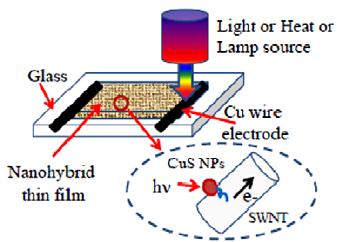Thermoelectric generator converts light and heat to electrical current
November 13, 2012

(Credit: Yi-Hsuan Tseng et al./Nanotechnology)
University of Texas at Arlington associate physics professor Wei Chen has helped create a hybrid nanomaterial that can be used to convert light and thermal energy into electrical current, surpassing earlier methods that used either light or thermal energy, but not both.
The team synthesized a combination of copper sulfide nanoparticles and single-walled carbon nanotubes to build a prototype thermoelectric generator that they hope can eventually produce milliwatts of power.
Paired with microchips, the technology could be used in devices such as self-powering sensors, low-power electronic devices and implantable biomedical micro-devices, Chen said.
“If we can convert both light and heat to electricity, the potential is huge for energy production. By increasing the number of the micro-devices on a chip, this technology might offer a new and efficient platform to complement or even replace current solar cell technology.”
In lab tests, the new thin-film structure showed increases by as much at 80 percent in light absorption when compared to single-walled nanotube thin-film devices alone, making it a more efficient generator.
Copper sulfide is also less expensive and more environment-friendly than the noble metals used in similar hybrids.
The researchers also say also found that they could enhance the thermal and optical switching effects of the hybrid nanomaterial as much as ten times by using asymmetric illumination, rather than symmetric illumination.
Chen is currently receiving funding from the U.S. Department of Defense to develop nanoparticle self-lighting photodynamic therapy for use against breast and prostate cancers. In 2010, he was the first to publish results in the journal Nanomedicine demonstrating that near infrared light could be used to heat copper sulfide nanoparticles for photothermal therapy in cancer treatment, which destroys cancer cells with heat between 41 and 45 degrees Celsius.
Next month, the Journal of Biomedical Nanotechnology will publish Chen’s work successfully coupling gold nanoparticles with the copper sulfide nanoparticles for the photothermal therapy. Such a material would be less costly and potentially more effective than using gold particles alone, Chen said.
Chen is also leading a UT Arlington team exploring ways to develop various nanoparticles for radiation detection. That work is funded by a $1.3 million grant from the National Science Foundation and the U.S. Department of Homeland Security.